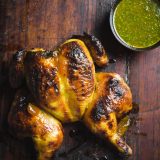The lacquered look of a glazed and roasted chicken may be alluring, but it also can be a trial to execute well. The sugar in glazes caramelizes in the oven, adding deep sweet-savory notes to the meat. The sugar also reacts with the proteins in the meat, intensifying browning.
Unless the glaze drips off, as so many do. Then all they do is create a sticky, scorched mess on your pan.
We found our solution in a well-tested technique for ensuring chickens cook evenly: spatchcocking. Left whole, the bird is shaped like a football, all but guaranteeing the easily overcooked breasts are more exposed to the heat, drying them out before the legs and thighs can finish. This also creates a hard-to-glaze bottom that rarely browns or crisps well.
Spatchcocking, or butterflying, involves cutting out and discarding a bird’s backbone so it can be spread open and flattened. This allows the chicken to cook and brown evenly. Turns out, it also makes it easier to get a glaze to spread evenly and stay put. With a whole chicken, glazes drip off, especially as they heat. But a flattened chicken can be glazed evenly and with little drippage.
Satisfied by our technique, we turned our attention to the glaze itself. We wanted a glaze that delivered maximum flavor with minimal effort. And we wanted bold flavors as well as enough sugar to ensure abundant browning. We came up with plenty of homemade options, but a turn down the supermarket’s international aisle provided an easier and just as delicious alternative: a jar of mango chutney.
The chutney provided the ideal balance of sweet and spice, especially after we bolstered it with ginger and earthy turmeric. To roast, we placed our chicken on a rack for air circulation and faster cooking. We cranked the oven up to 425°F, and applied a second layer of glaze midway through roasting for extra lacquering. And within an hour, we had a chicken with wonderfully burnished skin thanks to even roasting and ample—and drip-free—glaze.
Glazes tend to drip off whole chicken during roasting, creating a sticky, scorched mess on the pan and adding little flavor to the meat. Spatchcocking flattens the bird, cooking it more evenly and keeping the glaze in place.




